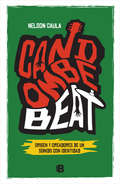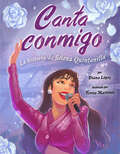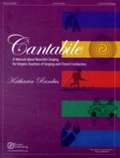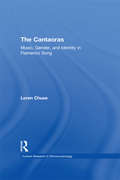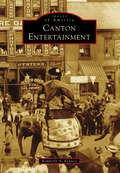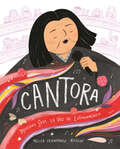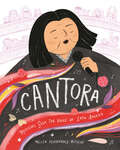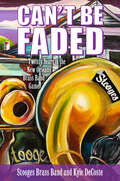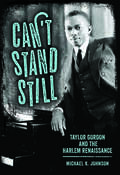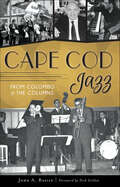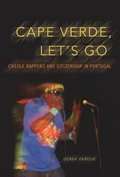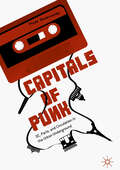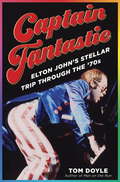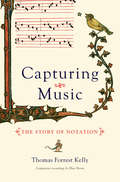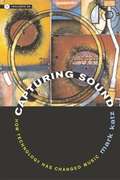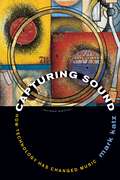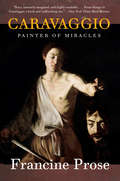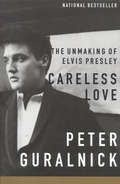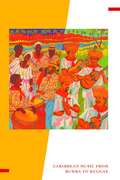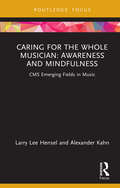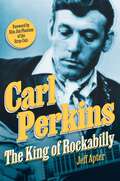- Table View
- List View
Candombe beat: Orígen y creadores de un sonido con identidad
by Nelson CaulaEl nuevo libro de Nelson Caula, en el que la pasión y la historia se mezclan para crear un ritmo propio de nuestro país. Del candombe beat, conocido género de la música popular uruguaya germinado en la década del sesenta, directamente vinculado al rock, su esencia más distintiva en el país, se ocupa este libro, abordado aquí en amplias aristas: historia, autores e intérpretes, discos y canciones, hitos preponderantes y su contexto político, social y cultural. Combinando historia, crónica, memoria y análisis, Nelson Caula nos ofrece una mirada muy personal, basada en una profunda reflexión a partir de la sistematización e investigación de su propio archivo, reunido en más de cuatro décadas e inédito hasta el momento. Desde los orígenes, un protocandombe beat prácticamente desconocido del afrouruguayo Pedro Ferreira y los Candombes de Vanguardia impulsados por Georges Roos, hasta la aparición de El Kinto, el primer conjunto emblemático que estrenó el género, pasando por todo su rutero de fuerte presencia en el país hasta los años setenta, cuya expresión local sólida concentra el grupo Totem, y su fuerte proyección de ahí en más, con sus referentes principales emigrados a Argentina, Europa y Estados Unidos, donde florece otro emblema de la corriente, ya muy abierta al jazz-rock y el funky: el grupo Opa. En esta obra coral desfilan los testimonios: los hermanos Fattoruso, Rada, Dino, Mateo, Jaime Roos, Diane Denoir, Urbano, Chichito Cabral, Juan Des Crescenzio, Manolo Guardia, Daniel Lagarde, Federico García Vigil; la historia de un país. De narrativa amena, disfrutable en anécdotas, aporta un completo panorama de un rico patrimonio musical uruguayo.
Canta conmigo: La historia de Selena Quintanilla
by Diana LópezUn libro de cuentos ilustrado que celebra la vida y el legado de Selena Quintanilla, la querida Reina de la Música Tejana.Desde su etapa mas temprana, la joven Selena sabía como conectarse con la gente y unirlos con la música. Canta conmigo sigue su ascenso al estrellato, desde su puesto al frente de la banda familiar, cantando en rodeos y fiestas de quinceañera, hasta su presentación frente a miles en el Astrodomo de Houston. Los lectores jóvenes se sentirán empoderados por la dedicación de Selena--aprendiendo el idioma español aún siendo adolescente, diseñando su propio vestuario, y viajando por toda la nación, compartiendo con el mundo el orgullo por sus raíces mexico-americanas y su amor a la música y a la moda.
Cantaba la rana / The Frog Was Singing
by Scholastic Rita Rosa RuesgaScholastic and Latin Grammy nominee Rita Rosa Ruesga have joined together to bring a wonderful bilingual songbook.¡Las canciones infantiles más populares de Latinoamérica! Con la letra de las canciones en español e inglés, las partituras correspondientes y hermosas ilustraciones, esta colección es una introducción ideal a la rica tradición musical de los países hispanohablantes. A los chicos les encantará.
Cantabile: A Manual about Beautiful Singing for Singers, Teachers of Singing and Choral Conductors
by Katharin RundusThis vocal pedagogy textbook breaks the mold. Filled with anatomical drawings, pictures, graphs and valuable vocal exercises, this book is wisely and attractively organized. Plus, every chapter includes a section specifically for the choral director!
Cantaoras: Music, Gender and Identity in Flamenco Song (Current Research in Ethnomusicology: Outstanding Dissertations #7)
by Loren ChuseThis book provides an in-depth ethnographic investigation of the greatly underestimated and underappreciated contributions of women singers, the cantaoras, to the creation, transmission and innovation in flamenco song. Situating the study of flamenco in the context of social and political currents that have shaped twentieth-century Spain, and drawing on interviews with the cantaoras themselves, Loren Chuse shows how flamenco is a complex of cultural practices at once musical, physical, verbal and social, involving the expression and negotiation of complex multi-layered identities, including notions of Andalusian, regional, gypsy and gender identity. Chuse shows how women are engaged in the formation of flamenco today, and how they respond to the balance and tensions between tradition and innovation. In so doing, she encourages a deeper appreciation of flamenco and initiates new approaches within ethnomusicology, feminist scholarship, flamenco, gender and popular music studies.
Cantar es mi mundo - Singen ist meine Welt: Spielräume zur Ermöglichung allgemeiner Bildungserfahrungen im Musikunterricht
by Stefan LückelStefan Lückel untersucht in der vorliegenden Arbeit, inwiefern im Kontext des vokalen Musizierens innerhalb des Musikunterrichtes der Sekundarstufen I und II - im Besonderen beim Singen - neben musikspezifischen auch allgemeine Bildungserfahrungen erzielt und nachgewiesen werden können. Grundlage dieser Untersuchung sind zunächst theoretische Vorüberlegungen zum allgemeinen und zum ästhetisch-musikalischen Bildungsbergriff sowie zum anderen eine Feldstudie, in der in Form einer musikpädagogisch-konzertierten Intervention verschiedene Kategorien Allgemeiner Bildung beobachtet und anschließend beschrieben werden. Hieraus entwickelt er eine musikdidaktische Konzeption (Didaktische Skizze), die theoretisch elaboriert und praxisbezogen eine didaktische Orientierung und Planungshilfe für Musiklehrer*innen bietet, unter welchen Bedingungen und in welcher Weise auch Erfahrungen und Kategorien Allgemeiner Bildung im Musikunterricht beim Singen erzielt werden können.
Canton Entertainment
by Kimberly A. KenneyEveryone loves to have fun! Over the years, Cantonians have enjoyed a wide variety of amusements, from traveling theatrical shows to community-wide celebrations. Louis Schaefer opened the town's first opera house in 1868, attracting some of the 19th century's biggest stars to Canton. The tradition of first-rate entertainment continued in the 20th century, with stars like Benny Goodman, Tommy Dorsey, and Guy Lombardo gracing the stage of the Moonlight Ballroom. During the Great Depression in the 1930s, Canton enjoyed a cultural renaissance with the development of many arts organizations still cherished today, including the Players' Guild, Canton Symphony Orchestra, and Canton Museum of Art. In 1955, the city celebrated its sesquicentennial with the biggest parade in Canton's history.
Cantora (Spanish Edition): Mercedes Sosa, la voz de Latinoamérica
by Melisa Fernández NitscheSing out! With a stunning, graphic style and a melodious text, this picture book tells the story of Latin American icon Mercedes Sosa and how she became the voice of a people from exile to triumph.What if a voice became a symbol of justice?I&’m here to offer my heart, said that voice.The folk rhythm of the bombo drum beats like a heart, with a resonant voice singing the truth of her people. Mercedes Sosa sang about what it means to be human, and her songs of struggle always spoke the truth of the injustice that so many workers and families in Latin America faced. As a teen, she won a local radio contest, and as her confidence grew, so did her fame. From a folk festival to Carnegie Hall and the Sistine Chapel, Mercedes performed the world over, sharing stories through song. But not everyone loved her singing: a military dictatorship ruled over Argentina, and they saw the power of her voice. Even from exile, Mercedes Sosa was a beacon of freedom for her people, and when she returned to her homeland, she persisted in her work: to be the voice of the voiceless.Adding a personal touch as a fellow Argentinean, Melisa Fernández Nitsche fills her debut picture book with bright and breathtaking illustrations that will surely inspire and empower young readers as they read about the impact one person's voice can have.
Cantora: Mercedes Sosa, the Voice of Latin America
by Melisa Fernández NitscheSing out! With a stunning, graphic style and a melodious text, this picture book tells the story of Latin American icon Mercedes Sosa and how she became the voice of a people from exile to triumph.What if a voice became a symbol of justice?I&’m here to offer my heart, said that voice.The folk rhythm of the bombo drum beats like a heart, with a resonant voice singing the truth of her people. Mercedes Sosa sang about what it means to be human, and her songs of struggle always spoke the truth of the injustice that so many workers and families in Latin America faced. As a teen, she won a local radio contest, and as her confidence grew, so did her fame. From a folk festival to Carnegie Hall and the Sistine Chapel, Mercedes performed the world over, sharing stories through song. But not everyone loved her singing: a military dictatorship ruled over Argentina, and they saw the power of her voice. Even from exile, Mercedes Sosa was a beacon of freedom for her people, and when she returned to her homeland, she persisted in her work: to be the voice of the voiceless.Adding a personal touch as a fellow Argentinean, Melisa Fernández Nitsche fills her debut picture book with bright and breathtaking illustrations that will surely inspire and empower young readers as they read about the impact one person's voice can have.
Can’t Be Faded: Twenty Years in the New Orleans Brass Band Game (American Made Music Series)
by Stooges Brass Band Kyle DeCosteThe Stooges Brass Band always had big dreams. From playing in the streets of New Orleans in the mid-1990s to playing stages the world over, they have held fast to their goal of raising brass band music and musicians to new heights—professionally and musically. In the intervening years, the band’s members have become family, courted controversy, and trained a new generation of musicians, becoming one of the city’s top brass bands along the way. Two decades after their founding, they have decided to tell their story. Can’t Be Faded: Twenty Years in the New Orleans Brass Band Game is a collaboration between musician and ethnomusicologist Kyle DeCoste and more than a dozen members of the Stooges Brass Band, past and present. It is the culmination of five years of interviews, research, and writing. Told with humor and candor, it’s as much a personal account of the Stooges’ careers as it is a story of the city’s musicians and, even more generally, a coming-of-age tale about black men in the United States at the turn of the twenty-first century. DeCoste and the band members take readers into the barrooms, practice rooms, studios, tour vans, and streets where the music is made and brotherhoods are shaped and strengthened. Comprised of lively firsthand accounts and honest dialogue, Can’t Be Faded is a dynamic approach to collaborative research that offers a sensitive portrait of the humans behind the horns.
Can’t Stand Still: Taylor Gordon and the Harlem Renaissance (Margaret Walker Alexander Series in African American Studies)
by Michael K. JohnsonBorn in 1893 into the only African American family in White Sulphur Springs, Montana, Emmanuel Taylor Gordon (1893–1971) became an internationally famous singer in the 1920s at the height of the Harlem Renaissance. With his musical partner, J. Rosamond Johnson, Gordon was a crucially important figure in popularizing African American spirituals as an art form, giving many listeners their first experience of black spirituals.Despite his fame, Taylor Gordon has been all but forgotten, until now. Michael K. Johnson illuminates Gordon’s personal history and his cultural importance to the legacy of the Harlem Renaissance, arguing that during the height of his celebrity, Gordon was one of the most significant African American male vocalists of his era. Gordon’s story—working in the White Sulphur Springs brothels as an errand boy, traveling the country in John Ringling’s private railway car, performing on vaudeville stages from New York to Vancouver to Los Angeles, performing for royalty in England, becoming a celebrated author with a best-selling 1929 autobiography, and his long bout of mental illness—adds depth to the history of the Harlem Renaissance and makes him one of the most fascinating figures of the twentieth century. Through detailed documentation of Gordon’s career—newspaper articles, reviews, letters, and other archival material—the author demonstrates the scope of Gordon’s cultural impact. The result is a detailed account of Taylor’s musical education, his career as a vaudeville performer, the remarkable performance history of Johnson and Gordon, his status as an in-demand celebrity singer and author, his time as a radio star, and, finally, his descent into madness. Can’t Stand Still brings Taylor Gordon back to the center of the stage.
Cape Cod Jazz: From Colombo to The Columns
by John A. BasileThe first notes of jazz hit Cape Cod in the very early days of the genre. Bournehurst-on-the-Canal hosted top bands, and emerging swing era dancers packed the hall. Cape Cod's "First Lady of Jazz," Marie Marcus, was a child prodigy in Boston and found some of her most important instruction in the art of stride piano during lessons with great pianist Fats Waller in New York. At the very tip of the Cape, the Atlantic House in Provincetown showcased performances from some of the biggest names like Gerry Mulligan, Billie Holiday and Stan Getz. Author John Basile details the fascinating history and amazing musicians that made Cape Cod a music destination.
Cape Verde, Let's Go: Creole Rappers and Citizenship in Portugal
by Derek PardueMusicians rapping in kriolu --a hybrid of Portuguese and West African languages spoken in Cape Verde--have recently emerged from Lisbon's periphery. They popularize the struggles with identity and belonging among young people in a Cape Verdean immigrant community that shares not only the kriolu language but its culture and history. Drawing on fieldwork and archival research in Portugal and Cape Verde, Derek Pardue introduces Lisbon's kriolu rap scene and its role in challenging metropolitan Portuguese identities. Pardue demonstrates that Cape Verde, while relatively small within the Portuguese diaspora, offers valuable lessons about the politics of experience and social agency within a postcolonial context that remains poorly understood. As he argues, knowing more about both Cape Verdeans and the Portuguese invites clearer assessments of the relationship between the experience and policies of migration. That in turn allows us to better gauge citizenship as a balance of individual achievement and cultural ascription. Deftly shifting from domestic to public spaces and from social media to ethnographic theory, Pardue describes an overlooked phenomenon transforming Portugal, one sure to have parallels in former colonial powers across twenty-first-century Europe.
Capitals of Punk: DC, Paris, and Circulation in the Urban Underground
by Tyler SonnichsenCapitals of Punk tells the story of Franco-American circulation of punk music, politics, and culture, focusing on the legendary Washington, DC hardcore punk scene and its less-heralded counterpart in Paris. This book tells the story of how the underground music scenes of two major world cities have influenced one another over the past fifty years. This book compiles exclusive accounts across multiple eras from a long list of iconic punk musicians, promoters, writers, and fans on both sides of the Atlantic. Through understanding how and why punk culture circulated, it tells a greater story of (sub)urban blight, the nature of counterculture, and the street-level dynamics of that centuries-old relationship between France and the United States.
Captain Fantastic: Elton John's Stellar Trip Through the '70s
by Tom DoyleBased on rare one-on-one interviews with the flamboyant rock ’n’ roll icon, this is the first book to trace Elton John’s meteoric rise from obscurity to worldwide celebrity in the wildest, weirdest decade of the twentieth century. In August 1970, Elton John achieved overnight fame with a rousing performance at the Troubadour in Los Angeles. Over the next five years, the artist formerly known as Reginald Dwight went from unheard of to unstoppable, scoring seven consecutive #1 albums and sixteen Top Ten singles in America. By the middle of the decade, he was solely responsible for 2 percent of global record sales. One in fifty albums sold in the world bore his name. Elton John’s live shows became raucous theatrical extravaganzas, attended by all the glitterati of the era. But beneath the spangled bodysuits and oversized eyeglasses, Elton was a desperately shy man, conflicted about his success, his sexuality, and his narcotic indulgences. In 1975, at the height of his fame, he attempted suicide. After coming out as bisexual in a controversial Rolling Stone interview that nearly wrecked his career, and announcing his retirement from live performance in 1977 at the age of thirty, he gradually found his way back to the thing he cared about most: the music. Captain Fantastic gives readers a behind-the-scenes look at the rise, fall, and return to glory of one of the world’s most mercurial performers. Rock journalist Tom Doyle’s insider account of the Rocket Man’s turbulent ascent is based on a series of one-pn-one interviews in which Elton laid bare many previously unrevealed details of his early career. Here is an intimate exploration of Elton’s working relationship with songwriting partner Bernie Taupin, whose lyrics often chronicled the ups and downs of their life together in the spotlight. Through these pages pass a parade of legends whose paths crossed with Elton’s during the decade—including John Lennon, Bob Dylan, Groucho Marx, Katharine Hepburn, Princess Margaret, Elvis Presley, and an acid-damaged Brian Wilson. A fascinating portrait of the artist at the apex of his celebrity, Captain Fantastic takes us on a rollicking fame-and-drug-fueled ride aboard Elton John’s rocket ship to superstardom.
Capturing Music: The Story Of Notation
by Thomas Forrest KellyAn entertaining history of how musicians learned to record music for all time, filled with art that sings. In today’s digital landscape, we have the luxury of experiencing music anytime, anywhere. But before this instant accessibility and dizzying array of formats—before CDs, the eight-track tape, the radio, and the turntable—there was only one recording technology: music notation. It allowed singers and soloists to travel across great distances and perform their work with stunning fidelity, a feat that we now very much take for granted. Thomas Forrest Kelly transports us to the lively and complex world of monks and monasteries, of a dove singing holy chants into the ear of a saint, and of bustling activity in the Cathedral of Notre Dame—an era when the only way to share even the simplest song was to learn it by rote, church to church and person to person. With clarity and a sense of wonder, Kelly tells a story that spans five hundred years, leading us on a journey through medieval Europe and showing how we learned to keep track of rhythm, melody, and precise pitch with a degree of accuracy previously unimagined. Kelly reveals the technological advances that led us to the system of notation we use today, placing each step of its evolution in its cultural and intellectual context. Companion recordings by the renowned Blue Heron ensemble are paired with vibrant illuminated manuscripts, bringing the art to life and allowing readers to experience something of the marvel that medieval writers must have felt when they figured out how to capture music for all time.
Capturing Sound: How Technology Has Changed Music
by Mark KatzMark Katz explores how recording technology has encouraged new ways of listening to music, led performers to change their practices, and allowed entirely new musical genres to come into existence.
Capturing Sound: How Technology Has Changed Music
by Mark KatzThere is more to sound recording than just recording sound. Far from being simply a tool for the preservation of music, the technology is a catalyst. In this award-winning text, Mark Katz provides a wide-ranging, deeply informative, consistently entertaining history of recording's profound impact on the musical life of the past century, from Edison to the Internet. Fully revised and updated, this new edition adds coverage of mashups and Auto-Tune, explores recent developments in file-sharing, and includes an expanded conclusion and bibliography. Illustrative sound and film clips can be found on the Media tab of the www.ucpress.edu product page.
Caravaggio: Painter of Miracles (Eminent Lives)
by Francine Prose“Matching gorgeous prose to gorgeous artworks, Prose responds to each image as a moment of theatrical revelation, sensual or spiritual, and frequently both.” — Boston Sunday GlobeIn Caravaggio, New York Times bestselling author Francine Prose offers an enthralling account of the life and work of one of the greatest painters of all time. Caravaggio defied the aesthetic conventions of his time; his use of ordinary people, realistically portrayed—street boys, prostitutes, the poor, the aged—was a profound and revolutionary innovation that left its mark on generations of artists. His insistence on painting from nature, on rendering the emotional truth of experience, whether religious or secular, made him an artist who speaks across the centuries to modern day. Called “racy, intensely imagined, and highly readable” by the New York Times Book Review, Caravaggio includes eight pages of color illustrations, and is sure to appeal to art enthusiasts interested in one of history’s true innovators. Caravaggio is part of the “Eminent Lives” series from HarperCollins, a selection of biographies by distinguished authors on canonical figures
Career Coward's Guide to Interviewing
by Katy PiotrowskiHelps readers sell their qualifications without "bragging," develop courageous responses to tough questions, and have the guts to ask for a better salary offer.
Careless Love: The Unmaking of Elvis Presley
by Peter GuralnickCareless Love is the full, true, and mesmerizing story of Elvis Presley's last two decades, in the long-awaited second volume of Peter Guralnick's masterful two-part biography.Last Train to Memphis, the first part of Guralnick's two-volume life of Elvis Presley, was acclaimed by the New York Times as "a triumph of biographical art." This concluding volume recounts the second half of Elvis' life in rich and previously unimagined detail, and confirms Guralnick's status as one of the great biographers of our time.Beginning with Presley's army service in Germany in 1958 and ending with his death in Memphis in 1977, Careless Love chronicles the unravelling of the dream that once shone so brightly, homing in on the complex playing-out of Elvis' relationship with his Machiavellian manager, Colonel Tom Parker. It's a breathtaking revelatory drama that for the first time places the events of a too-often mistold tale in a fresh, believable, and understandable context.Elvis' changes during these years form a tragic mystery that Careless Love unlocks for the first time. This is the quintessential American story, encompassing elements of race, class, wealth, sex, music, religion, and personal transformation. Written with grace, sensitivity, and passion, Careless Love is a unique contribution to our understanding of American popular culture and the nature of success, giving us true insight at last into one of the most misunderstood public figures of our times.
Caribbean Currents: Caribbean Music from Rumba to Reggae (Studies In Latin America And Car)
by Peter Manuel Michael LargeyFirst published in 1995, Caribbean Currents has become the definitive guide to the distinctive musics of this region of the world. This third edition of the award-winning book is substantially updated and expanded, featuring thorough coverage of new developments, such as the global spread of reggaeton and bachata, the advent of music videos, the restructuring of the music industry, and the emergence of new dance styles. It also includes many new illustrations and links to accompanying video footage. <P><P> The authors succinctly and perceptively situate the musical styles and developments in the context of themes of gender and racial dynamics, sociopolitical background, and diasporic dimensions. Caribbean Currents showcases the rich and diverse musics of Cuba, Puerto Rico, the Dominican Republic, Jamaica, Trinidad, the French Caribbean, the lesser Antilles, and their transnational communities in the United States and elsewhere to provide an engaging panorama of this most dynamic aspect of Caribbean culture.
Caring for the Whole Musician: CMS Emerging Fields in Music (CMS Emerging Fields in Music)
by Larry Lee Hensel Alexander KahnCaring for the Whole Musician brings together insights from two expert musicians and educators to consider the relationship between mental and physical health and artistic practice for musicians. Offering a holistic perspective that encompasses the whole being – body, mind, and heart – this book provides emerging musicians with tools, practices, and mindsets to address key challenges throughout their journey. The first part, Awareness, addresses wellness and embodiment in music, exploring how our bodies are constructed and how the use of our bodies as instruments affects function. Using approaches including Body Mapping and the Alexander Technique, this part helps readers discover adverse habits that interfere with natural movement, and nurture awareness of the body. The second part, Mindfulness, explores how meditative practice can be incorporated into every stage of concert preparation and embedded within the daily life of the musician. Offering mindfulness exercises related to each stage of the music-making process, these chapters provide strategies for readers to enhance their well-being and focus. Centered in the understanding of the musician as a whole being, this book provides an essential guide to how practices of awareness and mindfulness can allow musicians to better care for themselves and flourish in their artistic careers.
Caring for the Whole Musician: CMS Emerging Fields in Music (CMS Emerging Fields in Music)
by Larry Lee Hensel Alexander KahnCaring for the Whole Musician brings together insights from two expert musicians and educators to consider the relationship between mental and physical health and artistic practice for musicians. Offering a holistic perspective that encompasses the whole being – body, mind, and heart – this book provides emerging musicians with tools, practices, and mindsets to address key challenges throughout their journey.The first part, Awareness, addresses wellness and embodiment in music, exploring how our bodies are constructed and how the use of our bodies as instruments affects function. Using approaches including Body Mapping and the Alexander Technique, this part helps readers discover adverse habits that interfere with natural movement, and nurture awareness of the body. The second part, Mindfulness, explores how meditative practice can be incorporated into every stage of concert preparation and embedded within the daily life of the musician. Offering mindfulness exercises related to each stage of the music-making process, these chapters provide strategies for readers to enhance their well-being and focus.Centered in the understanding of the musician as a whole being, this book provides an essential guide to how practices of awareness and mindfulness can allow musicians to better care for themselves and flourish in their artistic careers.
Carl Perkins: The King of Rockabilly
by Jeff ApterThe definitive and fascinating biography of the musical trailblazer who was the influence behind countless legendary hits, a rock and roll legend in his own right, and the original rockabilly cat—Carl Perkins. He was the King of Rockabilly, and one of rock and roll&’s true pioneers. A groundbreaking guitarist, singer, and songwriter, Carl Perkins inspired countless musicians in country, rock, and pop music. As Paul McCartney said, &“If there were no Carl Perkins, there would be no Beatles.&” One Beatle was such a fan that he gave himself the stage name Carl Harrison. Now acclaimed music writer Jeff Apter recounts Carl&’s remarkable life story—the triumphs, tragedies, and career highlights that include some of the most pivotal moments in music history. Born in Tennessee to poor sharecroppers, Carl grew up listening to gospel and country music, learned blues guitar from a fellow field hand, and started writing songs at age fourteen. He plied his trade in rough and rowdy honky-tonks, performing with his brothers before beginning his recording career at the legendary Sun Studio in Memphis. It was there that Carl became a member of the fabled &“Million Dollar Quartet,&” alongside Elvis Presley, Johnny Cash, and Jerry Lee Lewis. In 1955, he wrote and recorded &“Blue Suede Shoes,&” the first record by a Sun artist to sell over a million copies. But then a fateful car crash stalled his career, one of many tragedies in his life. Over the following decades, Presley, Cash, and countless other artists, from the Beatles, Tom Petty, and Bob Dylan to Eric Clapton and Jimi Hendrix, performed and recorded his songs and became Carl&’s friends, collaborators, and champions. Rich with insider detail and background into Carl&’s private battles, humanitarian work, and personal inspirations, this is a fascinating, in-depth look at &“Mr. Blue Suede Shoes&” and his one-of-a-kind legacy.
